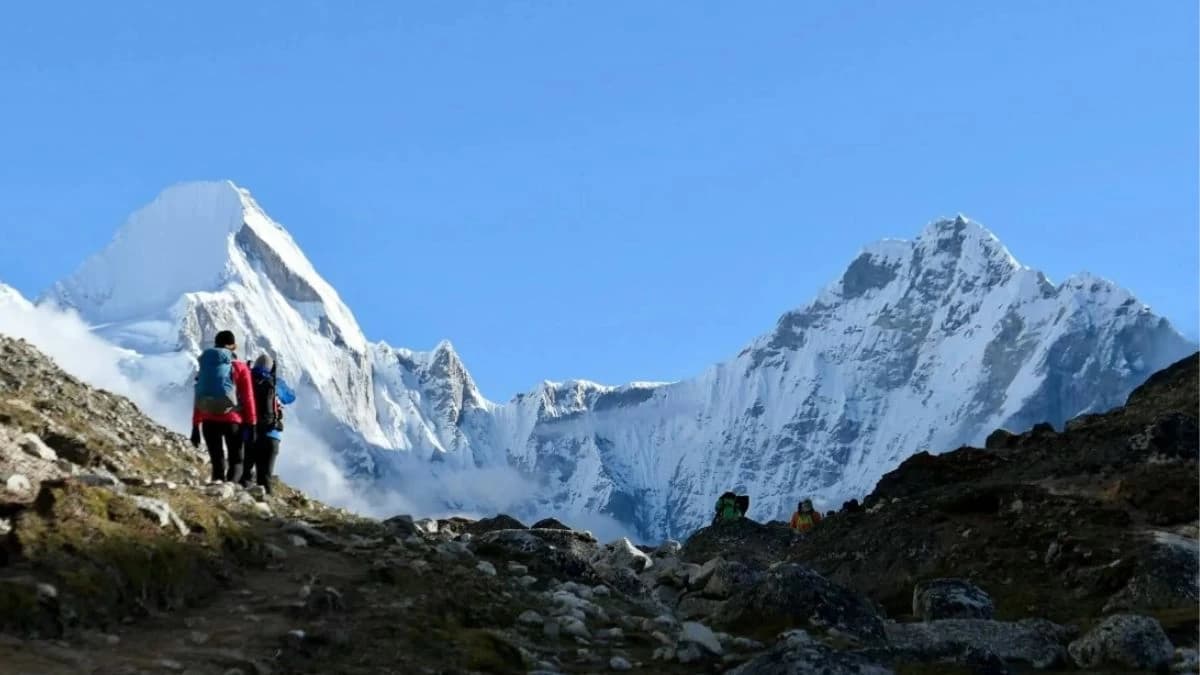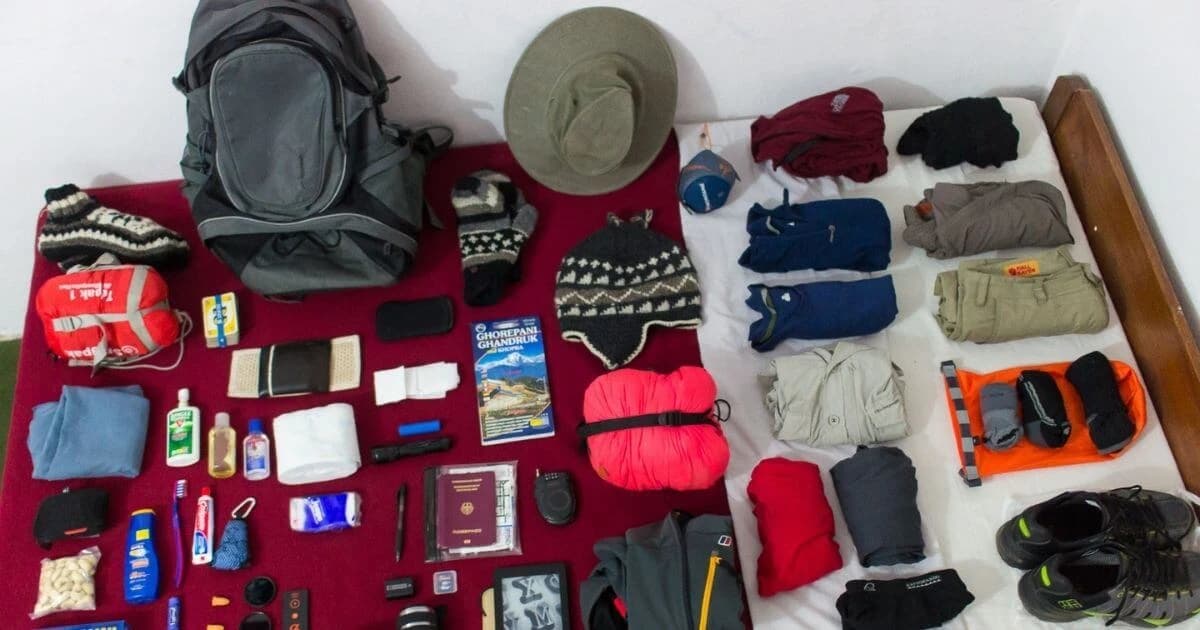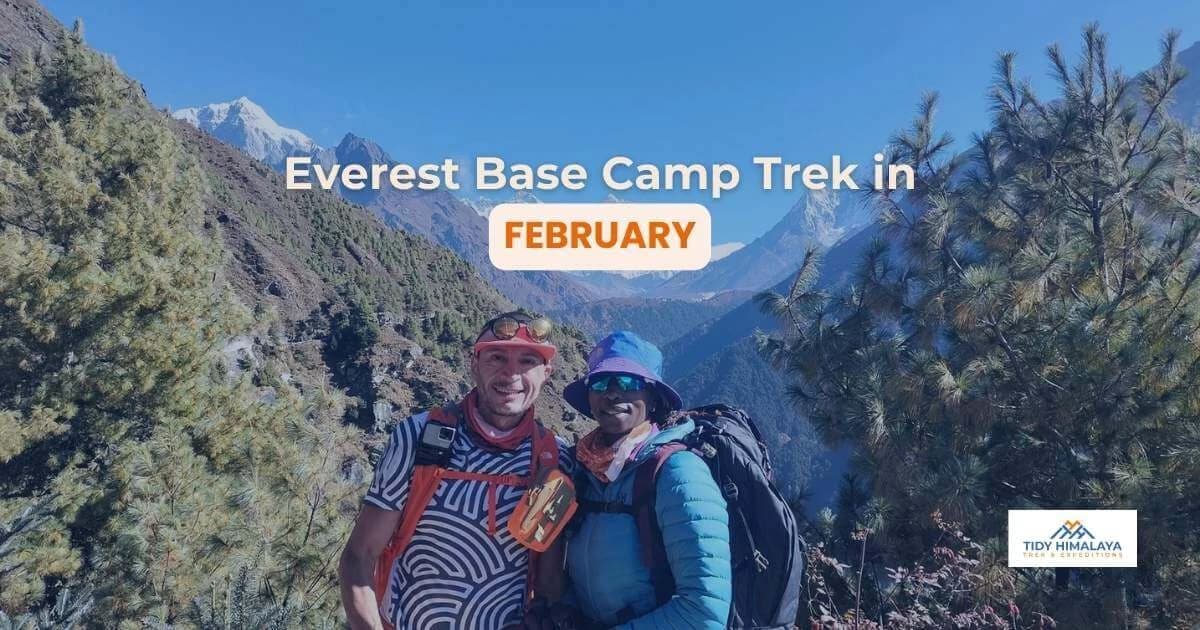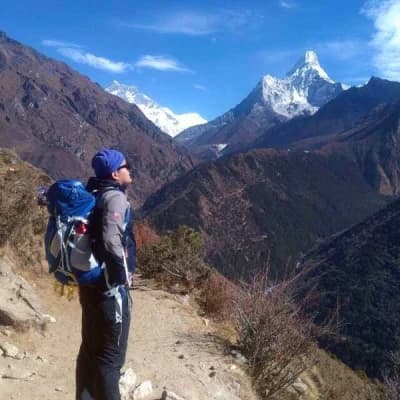Heading to Everest Base Camp Trek in February? Strap in because you’re about to embark on a truly epic adventure! This EBC trek isn’t just a journey; it’s a dream destination for adventurers from all corners of the globe.
And in February, it’s even more special—trekking through the heart of the Nepalese Himalayas on peaceful, pristine trails under a crystal-clear winter sky.
What makes February so unique? The trails are less crowded, giving you a golden opportunity to truly connect with nature as if the mountains are putting on a private show just for you. Plus, with the onset of spring, the weather starts to soften a bit, bringing excellent, crisp temperatures and breathtaking views of the Himalayas.
The serene beauty of this iconic EBC trek in February is something you don’t want to miss!!
Now, let’s talk about what to expect from the weather. February can be chilly, with some extreme temperatures at higher altitudes. But don’t worry; we’ll walk you through how to gear up and prepare for the cold for Everest Region trekking. Proper preparation is critical to ensuring your adventure is breathtaking but also safe and comfortable.
Ready to get started? This article has all the insights you’ll need to tackle the Everest Base Camp trek in February. We’ll ensure you’re well-equipped to handle the challenges and soak in all that spectacular scenery.
Overview of Everest Base Camp Trek in February
February is the last month of winter, bringing a touch of spring warmth to the chilly mountain air. Despite the cold, February offers breathtaking views of Mount Everest, Lhotse, Nuptse, and Ama Dablam, a major highlight of the trek.
February might be off the peak season radar, but it packs some unique perks that make it a fantastic time for an Everest Base Camp adventure. Here’s why you should consider packing your bags for this wintery trek in February:
- Crystal Clear Views: You won’t believe how clear the skies are in February! The air is crisp, so you get these stunning, uninterrupted views of Everest and its neighboring peaks.
- Quieter Trails: If you enjoy having space and time, you’ll love February on the trails. It’s less crowded, so you can soak in the silence and splendor without bumping elbows with other trekkers.
- Cultural Festivities: February is when you can experience Sonam Lhosar, the Tibetan New Year, and Basanta Panchami, which marks the onset of spring. It’s all colors, music, and delightful traditions—a total blast!
- Serenity of Winter: There’s something about winter at Everest Base Camp that’s incredibly peaceful. The snowy landscape has a quiet beauty that makes you feel like you’re in another world.
- Great Deals: Everest Base Camo trekking in February can also be kinder to your wallet. Fewer people trekking means better deals, from flights to cozy tea houses. Who doesn’t love a good discount?
- Wildlife Sightings: With fewer trekkers, the local wildlife gets bolder.
- Ideal Photography Conditions: Bring your camera because the photo ops are incredible. The light is just right, the scenes are postcard-perfect, and the night skies are stellar.
Recommended Read: Why is Everest Base Camp Popular
Weather in February: What to Expect
Even though February is one of the chillier months, it’s an incredible time to hit the Everest Base Camp trail.
February temperatures in Everest Base Camp stay between -15°C and -5°C during the day, but they get even colder at night.
So, how do you stay comfortable? Layering is your best friend. Think of thermal wear, insulated layers, and a good windproof jacket to shield you from the brisk mountain air. Dressing right is crucial—it can make or break your trekking experience. Remember, with the right gear, you can enjoy the breathtaking scenery without freezing up!
Is February a Good Time to Visit Everest Base Camp?
Absolutely! February is the best time to trek to Everest Base Camp. As winter ends, the melting snow creates stunning icy landscapes and provides clear views of glaciers unique to this time of year. The return of birds to the Everest region after winter adds a pleasant and natural soundtrack to your trek, with their cheerful chirping accompanying you along the way. Additionally, February offers the first peek of spring flowers and plants returning to life, with early buds and fresh green leaves beginning to emerge, adding a touch of vibrant color to the rejuvenating landscape.
Accommodation and Food in EBC Trek in February
Accommodation
Accommodation along the Everest Base Camp route consists of tea houses and lodges. These establishments offer basic yet comfortable rooms, perfect for weary trekkers to rest and recharge.
In February, the tea houses and lodges are barely filled by people as this month falls in the off-season. This makes anyone who treks in February a lucky trekker, as they can have multiple choices in lodging. You only have to compete with a few people to get a room in the best lodges.
While the accommodations may not be as luxurious as you might hope, with essential amenities, the warm blankets and heated common areas provide much-needed comfort after a day of trekking.
Food
While the food options along the trek are varied, you cannot expect the same quality as you might find in Kathmandu. Due to the lack of transportation, food costs tend to increase as you ascend altitude.
Teahouses offer a variety of meals to keep you nourished for the trek, such as Dal Bhat, noodles, and soups, as well as essential Western dishes like pasta and pancakes. Hot beverages like tea and coffee are also readily available to help you stay warm and hydrated.
Note: Food costs increase with altitude on the Everest Base Camp trek due to the logistical challenges of transporting supplies in the remote and rugged terrain of the Himalayas. It is recommended not to bargain with food prices, as they reflect the considerable efforts and costs of delivering supplies to these high-altitude regions.
Electricity and Internet Availability
Electricity: Electricity is available throughout the Everest Base Camp trek, but the type varies. Charging your devices is possible at most tea houses and lodges, though it typically costs extra. Be prepared to spend more on charging if you’re not careful.
Charging sockets are usually found in common areas like dining halls or near reception desks, not in individual rooms unless you stay in high-end lodges or rooms with attached bathrooms.
Internet: Internet options in the Everest region include the dedicated ISP Everest Link and mobile networks from providers like NCell and NTC.
Best Deals Provided by Tidy Himalaya for Everest Base Camp Trek in February
At Tidy Himalaya, we understand that your Everest Base Camp trek is more than just a journey; it’s an adventure of a lifetime. That’s why we’re proud to offer exclusive deals designed to provide you with the best possible experience while exploring the breathtaking beauty of the Himalayas in February.
You have plenty of options to cater to your preferences, as we offer a variety of deals tailored to meet your demands. Here are the top-rated and most sought-after deals for your Everest Base Camp trek.
Advantages of Everest Base Camp Trek in February
Trekking Everest Base Camp in February is a special and rewarding experience. The clear, bright skies give you amazing views of the snow-covered mountains, including Mount Everest, against a stunning blue backdrop.
As the snow melts, it creates beautiful icy scenes and clear glacial views, with sparkling streams and rivers making the scenery even more attractive.
You’ll see the first signs of spring, with new buds and green leaves starting to grow, which you won’t see at other times. Birds also start to come back, adding cheerful chirping sounds to your trek.
Additionally, February is part of the off-season, which means fewer trail crowds and better accommodation options. Many trekking agencies and lodges offer off-season discounts, making flights, tea houses, and accommodation services cheaper than in peak seasons. Despite the discounts, the quality of service remains high, as locals do not compromise on their hospitality.
The weather in February is generally clear, with low chances of precipitation, making the trek more manageable. While snowfall might be at higher altitudes, the overall conditions are favorable. The combination of winter’s end and spring’s beginning offers views and experiences you can’t get at any other time.
Major Attraction of the Everest Base Camp Trek in February

Lukla Airport, or Tenzing-Hillary Airport, is considered one of the world’s most thrilling and dangerous airports. It is located amidst breathtaking scenery and serves as the starting point of the Everest Base Camp trek. The airport offers stunning views, making it feel like floating among the clouds. It holds historical significance as the first stop for Sir Edmund Hillary and Tenzin Norgay Sherpa on their legendary journey. The nearby Lukla village serves as the gateway to Everest Base Camp.
Kala Patthar is the highest point on the Everest Base Camp trek at 5,545 meters. It provides an unmatched panoramic view of Mount Everest and surrounding peaks and is an ideal spot to see the Khumbu Glacier and icefalls, offering an awe-inspiring experience.
Sagarmatha National Park, the highest national park in the world, ranges from 6,000 to 8,848.86 meters and encompasses numerous mountains, rivers, peaks, valleys, and glaciers. It is home to endangered species like snow leopards, red pandas, and hornbills and around 3,000 Sherpa people. The park’s well-preserved natural beauty makes it a must-visit destination.
Namche Bazaar, often called the gateway to Everest, is a vivid town filled with restaurants, pubs, and shops selling trekking gear. While prices may be higher, Namche Bazaar offers a perfect rest stop for trekkers, with its sloping terrain providing breathtaking views of the Himalayas.
Preparations Needed for the Everest Base Camp Trek in February
Being well-prepared before hiking to Everest Base Camp in February is essential. Consider the following tips to ensure a safe and successful journey.
Physical Preparation
Physical fitness is crucial for the demanding Everest Base Camp trek. To build stamina and endurance, begin with cardiovascular training such as running, cycling, or swimming. Strength training should focus on leg and core exercises like squats, lunges, and planks to enhance stability and strength. Regular hiking with a loaded backpack simulates trekking conditions and helps build endurance. It’s advisable to start your cardio exercises at least three months before the trek to ensure you are well-prepared.
Mental Preparation
Mental preparation is key for the Everest Base Camp trek. Research its challenges and expectations thoroughly. Seek insights from fellow trekkers’ blogs or videos, as they offer invaluable practical tips. Cultivate a positive mindset by recalling your motivations, ensuring unwavering motivation for this adventure.
Packing Necessary Gear
Weather at high altitudes like Everest Base Camp is unpredictable, especially in February, one of Nepal’s coldest months. Only pack essential items like warm clothes, waterproof layers, gloves, hats, goggles, sunscreen, water, and a first aid kit. Avoid overpacking since the distance is long, and you must walk a lot. Thoroughly research our blogs; feel free to call us for more advice. Whatever you do, don’t compromise on packing essentials.
Necessary Documents for Everest Base Camp Trek:
- Sagarmatha National Park Entry Permit
- TIMS (Trekkers’ Information Management System) card.
- Passport and passport-sized photos
- Travel Insurance (Which covers high-altitude trekking and emergency evacuations)
Hiring a Professional Guide
Hiring a professional guide can significantly enhance your trekking experience. Guides offer valuable knowledge about the route, assist with navigation, and provide support in emergencies. They enrich your journey with insights into the local culture and environment, making your trek more informative and enjoyable. A guide’s expertise can also help you manage the trek more efficiently, ensuring safety and making your journey to Everest Base Camp in February memorable.
For the best trekking experience in Nepal, consider booking with Tidy Himalaya, a leading travel agency in Nepal. We offer top-notch services for the Everest Base Camp trek, providing experienced guides, personalized itineraries, and exceptional support throughout your journey.
Packing Lists for Everest Base Camp Trek in February

Clothing
- Thermal layers (2 sets)
- Down jacket
- Waterproof jacket and pants
- Insulated gloves
- Warm hat
- Wool socks (3 pairs)
- Trekking pants (2 pairs)
- Long-sleeve shirts (3)
- Fleece jacket
- Gaiters
- Underwear (3-4)
- Footwear
- Sturdy trekking boots
- Camp shoes or sandals
- Accessories
- Sunglasses
- Sunscreen
- Backpack with rain cover
- Water bottles (2) and purification
- tablets (sufficient quantity)Trekking poles
- Sleeping bag (rated for cold weather)
- Snacks and energy bars (enough for the entire trek)
- Headlamp with extra batteries
- Mixed Energy Bar
Personal Items
- Personal first aid kit
- Essential documents: permits, ID, emergency contacts
- Toiletries (toothbrush, toothpaste, wet wipes, etc.)
Read our Blog “What to Pack for Everest Base Camp Trek?” for more details.
Short Itinerary for Everest Base Camp Trek in February
Day 1: Arrive in Kathmandu.
Day 2: Fly to Lukla and trek to Phakding.
Day 3: Trek from Phakding to Namche Bazaar.
Day 4: Acclimatization day in Namche Bazaar.
Day 5: Trek from Namche Bazaar to Tengboche.
Day 6: Trek from Tengboche to Dingboche.
Day 7: Acclimatization day in Dingboche.
Day 8: Trek from Dingboche to Lobuche.
Day 9: Trek from Lobuche to Gorak Shep and visit Everest Base Camp.
Day 10: Hike to Kala Patthar, trek back to Pheriche.
Day 11: Trek from Pheriche to Namche Bazaar.
Day 12: Trek from Namche Bazaar to Lukla.
Day 13: Fly back to Kathmandu.
How To Avoid Altitude Sickness while Trekking to Everest Base Camp in February
It is essential to take certain precautions to minimize the risk of altitude sickness. Here are some essential tips to help you stay healthy and enjoy your trek:
- Ascend Slowly: Take your time and avoid rushing the trek. Gradual ascent allows your body to adapt to the increasing altitude, reducing the risk of altitude sickness.
- Proper Acclimatization: Include acclimatization days in your itinerary. Spend extra nights at certain altitudes to help your body adjust. For example, rest days in Namche Bazaar and Dingboche are essential.
- Stay Hydrated: Drink plenty of warm water throughout the trek. Staying hydrated helps your body cope better with high altitudes. Aim for at least 3-4 liters of water per day.
- Eat Well: Maintain a balanced diet with sufficient carbohydrates. Focus on high-energy foods like pasta, rice, and potatoes, and try to have regular meals even if your appetite decreases.
- Use Medications if Needed: After consulting with a doctor, consider taking altitude sickness medication like Diamox (Acetazolamide). This can help prevent and manage symptoms.
- Get Enough Sleep: Ensure you get adequate rest each night. Proper sleep is essential for recovery and helps your body adjust to high altitudes.
Recommended Read: Difficulties of Everest Base Camp Trek
Some Alternative Routes to Everest Base Camp Trek in February
Traditional Everest Base Camp Trek
The classic Everest Base Camp Trek starts in Lukla and takes you through the beautiful Khumbu Valley to Everest Base Camp. Most trekkers begin in Kathmandu, where Nepal’s international airport is located. This popular route, chosen by 95% of trekkers, takes about 10 days.
The adventure begins with an exhilarating flight from Kathmandu to Lukla. You’ll follow the Dudh Kosi River past Phakding to the bustling Namche Bazaar. After a rest day in Namche, where you’ll get your first breathtaking views of Everest, the trek continues to the serene Tengboche, then along the Imja Khola to Dingboche. The journey ascends the Khumbu Glacier’s terminal moraine, stopping at Lobuche before the final push to Gorakshep (5,164m) and Everest Base Camp. This trek promises an unforgettable adventure filled with stunning landscapes.
Three Passes and Everest Base Camp Trek
Three Passes trek is an adventure lover’s dream, offering some of the best trekking in Nepal and an incredible alternative route to Everest Base Camp. It’s a challenging but rewarding journey, crossing three high passes above 5,000m and providing stunning views of giants like Cho Oyu (8,201m), Makalu (8,463m), Lhotse (8,516m), and Everest (8,850m). Starting from Lukla, this trek diverges at Namche, following the Bhote Koshi Canyon for several days before crossing Renjo La (5,360m) into the enchanting Gokyo Valley.
After a rest day and an optional climb of Gokyo Ri, the route continues down the mighty Ngozumpa Glacier, over Cho La (5,400m), and finally to Gorak Shep for a visit to Everest Base Camp. From there, it takes you over Kongma La (5,535m) with fantastic views of Cholatse, Pokalde, and Ama Dablam before returning to Lukla via Tengboche and Namche.
Jiri to Everest Base Camp Trek
The Jiri to Everest Base Camp trek is an unforgettable adventure that takes you through stunning mountain views and follows the legendary footsteps of Hillary and Tenzing. Imagine trekking through snow-capped peaks, including Mount Everest, Khumbu Glacier, and Kala Patthar, all while soaking in the awe-inspiring scenery.
For those seeking an off-the-beaten-path experience, start with a scenic bus ride from Kathmandu to Jiri. Although the route from Jiri to Lukla is challenging, with numerous valleys and ridges to cross, it’s an actual test of endurance and spirit. Once you reach Lukla, you’ll join the traditional route to Everest Base Camp, experiencing the lower Himalayas’ remote beauty and the higher elevations’ grandeur. This trek promises to leave you with lifetime-lasting memories and stories to tell.
For more detailed information, visit our Everest Base Camp Trek Guide.
Conclusion
With proper preparation, trekking to Everest Base Camp in February 2024-2025 is entirely doable and offers the most beautiful adventure that other months cannot replicate. The serene trails, optimal weather conditions, and fewer crowds make February an ideal time to experience the breathtaking beauty of the Himalayas. Even though the temperature can be harsh sometimes, the journey will be worth it when you arrive at the destination and see the majestic mountains surrounding you. This could be your best adventure yet, offering unparalleled views and unforgettable memories.
FAQs
How cold does it get at Everest Base Camp in February?
Daytime temperatures at Everest Base Camp in February generally range between -15°C to -5°C (5°F to 23°F). At night, temperatures can drop to around -20°C (-4°F).
Recommended Read: How Cold is Everest Base Camp Trek
Are teahouses and lodges open in February?
Yes, teahouses and lodges along the Everest Base Camp trek are open in February. Despite the cold weather, they remain operational, offering warm rooms and meals. You can enjoy more personalized service and better room availability with fewer crowds.
Are mobile networks and WiFi available on the trek in February?
Mobile networks and WiFi are available on the Everest Base Camp trek in February. Major providers like Ncell and NTC offer coverage in most trekking areas, though the signal can be weak in remote parts. Many teahouses also provide WiFi, though it may be slow and comes at an extra cost.
Do I need special Everest Base Camp trek permits?
Yes, you need special permits for the Everest Base Camp trek. The main permits required are the Sagarmatha National Park Entry Permit, the TIMS (Trekkers’ Information Management System) card, and the Khumbu Pasang Lhamu Rural Municipality Entrance Permit.
What food is available during the Everest Base Camp trek?
During the Everest Base Camp trek, teahouses and lodges offer various food options. Traditional Nepalese meals include dal bhat (rice, lentil soup, and vegetables), noodle soups, and momos.
What about emergency evacuation options during the Everest Base Camp Trek?
Emergency evacuation options are available during the Everest Base Camp trek, primarily through helicopter services. In severe altitude sickness, injury, or other medical emergencies, a helicopter can quickly transport you to medical facilities in Kathmandu.
Is Guide Mandatory for Everest Base Camp Trek in February?
Although a guide is not mandatory for the Everest Base Camp trek in February, it is highly recommended. Winter conditions can be harsh and unpredictable. A guide offers valuable route knowledge, navigation assistance, and emergency support, ensuring a safer and more enjoyable trek.
Recommended Read: Can You Trek to EBC on Your Own?


.webp&w=1200&q=75&dpl=dpl_2PwU5ZDv8uoJ3KrzEVbz8N547HgX)
.webp&w=1200&q=75&dpl=dpl_2PwU5ZDv8uoJ3KrzEVbz8N547HgX)
.webp&w=1200&q=75&dpl=dpl_2PwU5ZDv8uoJ3KrzEVbz8N547HgX)